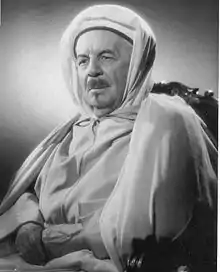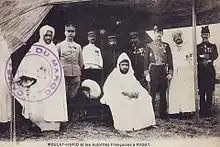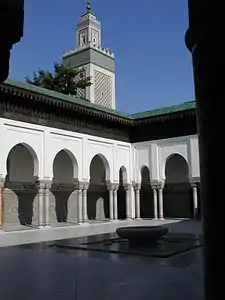Si Kaddour Benghabrit
Abdelkader Ben Ghabrit (Arabic: عبد القادر بن غبريط; Sidi Bel Abbes 1868 - 1954 Paris),[1] commonly known as Si Kaddour Benghabrit (سي قدور بن غبريط) was an Algerian religious leader, translator and interpreter who worked for the French Ministry of Foreign Affairs. He is most notable for being the first rector of the Great Mosque of Paris and for saving Jews and resistance fighters from the Nazis during the Second World War.
Si Kaddour Benghabrit | |
|---|---|
عبد القادر بن غبريط Abdelkader Ben Ghabrit | |
 | |
| Born | November 1, 1868 Sidi Bel Abbès, Algeria |
| Died | June 24, 1954 (aged 85) Paris, France |
| Relatives | Nouria Benghabrit (great-niece) |
Biography
Si Kaddour Benghabrit came from a prominent Andalusian family of Tlemcen. After his secondary education at the Madrasa Thaalibia in Algiers and the University of al-Karaouine of Fez[2] He started his career in Algeria, in the field of judiciary.
In 1892, he became assistant interpreter at the Legation of France to Tangier; he served as a liaison between North African officials and the French Ministry of Foreign Affairs.[3]
He served as chief of the French Legation in Tangier in the period 1900-1901.[4] In 1901, he served on the Franco-Moroccan commission to delineate the Algeria–Morocco border.[5]
He served the French delegation at the 1906 Algeciras Conference,[4][5] which formalized French preëminence in Morocco.[6]

Treaty of Fes
In 1912, he interpreted the negotiations between Sultan Abd al-Hafid of Morocco and the French diplomat Eugène Regnault which culminated in the signing of the Treaty of Fes, which established the French Protectorate in Morocco. Resident General Hubert Lyautey then rewarded him with a position as head of protocol to the sultan.[5][7]
World War I
In 1916, France sent him to Hijaz as head of the French diplomatic mission to Mecca to facilitate the Hajj and ensure the well-being of his fellow citizens during their time in the holy places of Islam, and to convince Hussein bin Ali, Sharif of Mecca to break with the Ottoman Empire and join the Allies,[5] assuring French support for an Arab caliphate.[8]
In 1917, Si Kaddour founded in the Mahkama of Algiers (civil court or qadi), the Society of Habous and the Holy Places of Islam, in order to facilitate the pilgrimage to Mecca by Muslims from French North Africa. The Society acquired two hotels in Medina and Mecca for use by pilgrims.
Intelligence
Throughout his career, Ben Ghabrit supplied France with valuable information about Muslim populations.[5] The Quai d'Orsay's Africa-Levant division described him as one of its "most trusted Arab informants."[5] In April 1920, he supplied the French premier and foreign minister Alexandre Millerand with a 23 page report on Muslim attitudes in North Africa and the Levant toward France, arguing for more autonomy in French colonies and support for the Paris Muslim Institute as a vital source of intelligence.[5]
Grand Mosque of Paris

In 1920, the Society of Habous and Holy Places of Islam established the Algiers prefecture. It intended to apply for authorization to construct an Institute and a Mosque in Paris, to have a structure to symbolize the eternal friendship of France and Islam, and memorialize the sacrifice of the tens of thousands of Muslim soldiers who died fighting in support of France during World War I, including at the Battle of Verdun. The Great Mosque of Paris was built in the 5th arrondissement, completed in 1926.
The Muslim Institute of the Paris Mosque was opened in Paris to aid all Muslims living in or visiting the area. It provided services and spiritual direction but also aided people with direct welfare if needed, as well as supporting new immigrants and acclimating them to the city.[9]
A sophisticated man and frequenter of Parisian salons, Ben Ghabrit was dubbed "the most Parisian Muslim".[10] During World War II and after the fall of France, Si Kaddour Ben Ghabrit worked to protect his people, both Muslims and Jews, arranging for forged papers for an estimated 100 Jews to certify them as Muslim.[11] He also arranged to have Jewish refugees hidden in the mosque at times of German roundups, and transported by the Resistance out of the country.[11] In addition, during the war in France, many Muslims joined the French Resistance movement.
World War II and Jews
During World War II, Si Kaddour Benghabrit saved the lives of at least five hundred Jews, including that of the Algerian singer Salim Halali, making the administrative staff grant them certificates of Muslim identity, which allowed them to avoid arrest and deportation.[12][13][14]
In a documentary entitled Mosque of Paris, the forgotten, produced for the show Racines de France 3 in 1991, Derri Berkani reports that it was the Algerian partisans, mainly composed of workers, who had led the Jews to the Paris Mosque for protection.[15] The mission of these Algerian partisans was to rescue and protect the British paratroopers and find them shelter. The Partisans subsequently provided assistance to Jewish families, from the families they knew, or at the request of friends, by accommodating them in the mosque, waiting for papers to be provided to get them to the Zone libre or cross the Mediterranean to the Maghreb.
The figures for the number of Jews saved by staying in the Mosque of Paris during this period differ according to the authors . Annie-Paule Derczansky, president of the Association des Bâtisseuses de paix, states that according to Albert Assouline, as stated in the Berkani film, 1600 people were saved. On the other hand, Alain Boyer, former head of religious affairs in the French Ministry of Interior, has stated that the number was closer to 500 people.
The Bâtisseuses de Paix, an association of Jewish and Muslim women working for inter-community harmony, submitted a petition in 2005 to Yad Vashem's Council to recognize that the Mosque of Paris saved many Jews between 1942 and 1944, and that Yad Vashem should thus recognize Si Kaddour Benghabrit as one of the Righteous Among the Nations.[16][17] This request remains unfulfilled, as no survivors have been found; apparently the mosque had worked with false passports.[18]
Si Kaddour Benghabrit's efforts to save Salim Halali and other Jews are depicted in the film Free Men, directed by Ismaël Ferroukhi and released in 2011. He is played by Michael Lonsdale.
Si Kaddour Benghabrit also inspired Mohamed Fekrane in his short film Together, released in 2010. The role of the imam is played by actor Habib Kadi.
Legacy and honors
For his contributions, Ben Ghabrit was awarded the Grand Cross of the Legion of Honour. He is buried in a reserved area to the North of the Mosque of Paris, according to the Maliki rite.
The French drama film Les hommes libres (Free Men, 2011) featured Ben Ghabrit and his work, and tells the story of Muslim contributions to the French Resistance. It starred French actor Michael Lonsdale as the Muslim rector.
Descendants
Nouria Benghabrit-Remaoun, sociologist and researcher, granddaughter of Si Kaddour Benghabrit's brother, is the Minister of National Education of Algeria.
Works
References
- / document.php ? id = 152 Dictionary of Orientalists in French
- mosquee-de-paris.org
- Paul R. Bartrop (6 June 2016). Resisting the Holocaust: Upstanders, Partisans, and Survivors: Upstanders, Partisans, and Survivors. ABC-CLIO. pp. 26–27. ISBN 978-1-61069-879-5.
- Fassi-Fihri, Mohammed (2008). Mon grand-père, ambassadeur à Paris: 1909-1910 (in French). Marsam Editions. ISBN 978-9954-21-138-0.
- Thomas, Martin (2008). Empires of Intelligence: Security Services and Colonial Disorder After 1914. University of California Press. ISBN 978-0-520-25117-5.
- Miller, Susan Gilson. (2013). A history of modern Morocco. New York: Cambridge University Press. ISBN 978-1-139-62469-5. OCLC 855022840.
- Pennell, C. R. (2000). Morocco Since 1830: A History. Hurst. ISBN 978-1-85065-273-1.
- IslamKotob. الشريف الحسين الرضي والخلافة لنضال داود المومني (in Arabic). IslamKotob.
- Official site of the Great Mosque of Paris
- Biography Si Kaddour Ben Ghabrit Official site of the Great Mosque of Paris
- Robert Satloff (October 8, 2006). "The Holocaust's Arab Heroes". The Washington Post. Retrieved 2010-04-28.
- "The Holocaust 's Arab Heroes", The Washington Post, October 8, 2006, Robert Satloff
- "Among the Righteous : Lost Stories of Arabs Who Saved Jews During the Holocaust " By Allan C. Brownfeld
- Ofer Aderet, The Great Mosque of Paris That saved Jews falling on the Holocaust, Haaretz, 24 March 2012.
- "Des juifs ont été sauvés par la Mosquée de Paris, L'association 'Les Bâtisseuses de paix' veut rappeler les faits" , Sunday, June 8, 2008 , SaphirNews.com
- Katz, Ethan (2013-03-01). "La Mosquée de Paris a-t-elle sauvé des juifs ? Une énigme, sa mémoire, son histoire". Diasporas. Circulations, Migrations, Histoire (in French) (21): 128–155. doi:10.4000/diasporas.271. ISSN 1637-5823. Retrieved 2019-03-21.
- "El Watan :: 16 mai 2005 :: Si Kaddour Benghabrit, un juste qui mérite reconnaissance". elwatan.com (in French). 2005-05-16. Archived from the original on 2010-04-06. Retrieved 2019-03-21.
- Muslime retten Juden. Es gibt sie, die orientalischen Schindlers, Frankfurter Allgemeine Zeitung, August 7, 2014, by Emran Feroz
- Ben-Gabrit, Si Kaddour (0000 uuuu). La Fondation Lyautey. [Signé: Gabriel Hanotaux, Paul Tirard. Un texte en arabe de Si Kaddour ben Gabrit (in French). Paris: Éditions Art et document. OCLC 458414527. Check date values in:
|date=(help) - Ben-Ghabrit (Si.), Kaddour (1930). Abou-Nouas, ou, L'art de se tirer d'affaire (in French). R. Couloumas.
- Ader. "[TERZIAN] - BEN GHABRIT (Si Kaddour). Abou-Nouas..." Ader (in French). Retrieved 2020-04-27.
Sources
- Abdellali Merdaci, Algerian French-language authors from the colonial period : Biographical Dictionary , L'Harmattan, 2010
- Biography of Si Kaddour Ben Ghabrit Official site of the Great Mosque of Paris